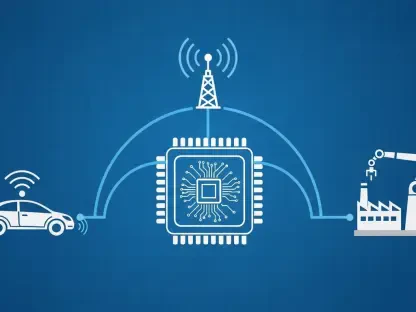Imagine a world where a smartphone can make a voice call from the most remote mountain peak or a disaster-stricken area with no cellular towers in sight, a reality now being forged by Skylo Technologies, a trailblazer in satellite communications. The company is breaking new ground by enabling satellite voice calls on standard smartphones, a development that promises to transform connectivity for millions in underserved and isolated regions. By integrating space-based networks with everyday mobile devices, Skylo is addressing critical gaps in traditional cellular infrastructure. This innovation aligns with the growing trend of non-terrestrial networks (NTN), where satellites act as floating cell towers to extend coverage beyond the reach of ground-based systems. As the demand for universal communication rises, Skylo’s approach could redefine how people stay connected in emergencies, rural areas, and beyond, setting a new standard for global accessibility.
Bridging Connectivity Gaps with Innovative Technology
Skylo Technologies stands out in the satellite communication landscape by leveraging cutting-edge solutions to bring voice calling to standard smartphones without the need for specialized hardware. The company employs 3GPP standards-based protocols and AI-powered codecs, achieving data transmission efficiency reportedly up to ten times greater than competitors. This technological edge has already shown promise with satellite texting on select Android devices like the Google Pixel 9 and Samsung Galaxy S25, and now extends to over-the-air voice calls via a narrowband NTN network. Such advancements eliminate the barriers posed by expensive, proprietary equipment, making satellite communication more accessible to everyday users. Strategic partnerships with industry leaders like Google, Verizon, and Qualcomm further enhance compatibility by integrating the technology into existing chipsets. This focus on seamless integration and cost-effective scalability positions Skylo to penetrate markets where traditional networks struggle, particularly in remote and rural settings.
Beyond the technical feats, Skylo’s vision centers on creating a hybrid connectivity model where smartphones can effortlessly switch between terrestrial and satellite signals. This approach addresses real-world challenges, such as providing reliable communication during natural disasters or in areas devoid of cellular infrastructure. Unlike broadband-focused satellite services that require dedicated terminals, Skylo’s direct-to-device solution targets the ubiquity of standard smartphones, catering to both individual consumers and enterprises. The phased rollout of services, starting with emergency messaging and progressing to voice calls, demonstrates a pragmatic strategy to build trust and functionality over time. Industry insights suggest this hybrid model could connect billions currently in connectivity deserts, offering a lifeline in critical situations. By prioritizing accessibility and leveraging existing technology, Skylo is carving a niche that complements rather than competes directly with traditional cellular networks, potentially reshaping global communication paradigms.
Navigating Challenges in a Competitive Landscape
While Skylo’s advancements are promising, the path to widespread adoption is fraught with obstacles that could temper its immediate impact. Regulatory hurdles and spectrum allocation issues remain significant barriers, as securing the necessary permissions across different regions can delay deployment. Additionally, initial support for satellite voice calls is limited to a small number of Android devices, narrowing the technology’s reach in its early stages. Concerns about latency and call quality under real-world conditions also persist, requiring extensive testing to ensure reliability. Competition from other players in the satellite-to-phone space, particularly those with expansive direct-to-cell ambitions, adds further pressure. Despite these challenges, Skylo’s focus on narrowband efficiency and emergency use cases creates a distinct market segment, allowing it to address specific needs that broader broadband solutions might overlook.
Another layer of complexity lies in the evolving competitive landscape of non-terrestrial networks, where multiple companies vie for dominance in direct-to-device connectivity. Skylo differentiates itself through strategic carrier partnerships and a commitment to integrating with existing hardware, giving it an edge in scalability and cost. Unlike competitors pursuing standalone infrastructure, Skylo relies on established satellite constellations, reducing deployment expenses and accelerating market entry. Industry observers note a growing interest in alternative connectivity solutions for remote areas, positioning Skylo as a valuable complement to traditional networks. Furthermore, the technology’s potential extends beyond smartphones to IoT devices such as wearables and sensors, opening doors to diverse applications across sectors. While hurdles remain, Skylo’s targeted approach and collaborative efforts suggest a strong foundation to navigate the competitive and regulatory challenges ahead, paving the way for broader impact.
Future Horizons for Global Communication
Looking ahead, Skylo Technologies is poised to play a pivotal role in the maturation of the NTN ecosystem, driven by advancements in chipset technology and strategic collaborations. The successful demonstration of satellite voice calls marks a significant step toward hybrid connectivity models that could redefine emergency response, global roaming, and rural access. This is particularly crucial in disaster-prone regions where communication infrastructure is often the first casualty. By fostering seamless integration between ground-based and orbital networks, Skylo addresses long-standing gaps that have left millions disconnected. The potential to support IoT applications also hints at a broader future where satellite connectivity underpins diverse technological ecosystems, from agriculture to logistics. As the company refines its offerings, it could catalyze a ripple effect, inspiring further innovation across the telecommunications industry.
Reflecting on the journey so far, Skylo’s efforts in bringing satellite voice calling to standard smartphones represent a defining moment in bridging global connectivity divides. The emphasis on accessibility, efficiency, and partnerships with industry giants lays a robust groundwork for challenging established norms in satellite communications. Although regulatory constraints and limited device compatibility pose initial setbacks, the successful rollout of voice calls and the vision of hybrid networks point to a transformative era. Moving forward, stakeholders can anticipate Skylo expanding its reach through continued testing and broader device support, ensuring reliability in diverse scenarios. This progress not only highlights the importance of NTN solutions but also underscores the critical role of emerging innovators in shaping telecommunications. As Skylo pushes boundaries, the industry stands to gain from enhanced competition, ultimately delivering universal connectivity to even the most isolated corners of the world.









